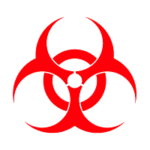A nosebleed, or epistaxis, is the release of blood from the tissue lining the inside of the nose. A combination of dry air and small blood vessels on the inside of your nose often causes nosebleeds. Nosebleeds can be annoying, but they are typically not a major concern. Most cases are mild, and only 6% of epistaxis cases are severe enough to necessitate medical intervention.
Approximately 60% of Americans experience a nosebleed at some point in their lives. Although they can occur at any age, children between the ages of 2 and 10 and adults between the ages of 50 and 80 are most likely to experience them. If you or your child develops a nosebleed, this blog covers a few ways how to stop a nosebleed, along with some prevention tips for you to follow.
What is Epistaxis?
The medical term used for a nosebleed is “epistaxis.” A nosebleed can happen in one or both nostrils, which is defined as bleeding from inside the nose. Typically, it affects only one nostril and may sometimes indicate underlying conditions like hypertension or coagulation disorders.
Your nose contains many tiny blood vessels. These vessels help to keep the air you breathe warm and moist. They are, however, near your nose’s inner layer. The blood vessels may become dry and irritated as air moves through your nose. This makes them highly prone to injury or breakage, resulting in a bloody nose.
Although annoying, most nosebleeds are minor and common. Approximately 60% of people will experience at least one nosebleed during their lifetime. Merely 10% of cases are severe enough to require medical intervention.
How Many Types of Nosebleeds Occur?
Healthcare providers describe epistaxis based on the specific location of the bleeding: anterior (from the front of the nose) and posterior (from the back). Anterior epistaxis is the most common type of nosebleed. Approximately 80-90% of nosebleeds are attributed to the anterior nasal blood supply.
These two types of nosebleeds are discussed as follows:
An anterior nosebleed originates from the septum, the thin wall that divides the two nasal passages. The front portion of the nose contains many delicate capillaries and small blood vessels, which are prone to breaking and bleeding. This type of nosebleed is frequently treatable at home and is typically not serious. Because of the fragility of their nasal blood vessels, it is more prevalent in children.
A posterior nosebleed occurs deeper in the nose, where larger blood vessels are located closer to the throat. This type of bleeding can be more severe and may cause blood to flow down the throat, potentially leading to choking or swallowing blood. Posterior nosebleeds are less common, accounting for about 5-10% of cases. However, they tend to be more severe. They require immediate medical attention due to the higher risk of significant blood loss. Immediate care can assist you in receiving a diagnosis or treatment for certain problems.
Top 10 Causes of Nosebleed
Nosebleeds often affect only one nostril but can occur in both. The majority of causes are manageable at home and are not very serious. Thus, when you are aware of common triggers, you can seek timely help, understand how to stop nose bleeding and reduce the associated risks. The 10 common causes of nosebleeds are discussed below:
The most frequent cause of anterior nosebleeds is dry air. Heated indoor air or dry climates can irritate and dry out the nasal membranes, creating crusts that easily bleed when touched or scratched. A humidifier with a humidity level upto 30-50% can keep nasal passages moist and avoid nosebleeds.
Frequent colds can irritate the nose’s inner lining, which leads to bleeding, especially after repeated nose blowing. Dry winter air can worsen the condition and increase the risk of nosebleeds. Thus, staying hydrated and using saline sprays may reduce irritation. However, an overuse of decongestant sprays can worsen nosebleeds.
- Allergies and Medications
Allergies can also be problematic, and a doctor may recommend medications like decongestants or antihistamines to treat a runny, itchy, or stuffy nose. However, decongestants can cause “rebound congestion”, leading to irritation and nosebleeds if overused. Additionally, the medication may cause nosebleeds by drying out the nasal membranes. They can also occasionally result from topical nasal medications like corticosteroids and antihistamines.
Although bleeding from a nose injury is possible, it is typically not a reason for concern. If you ever sustain a facial injury, follow the preventive tips to stop the bleeding. When the bleeding does not stop after 10 minutes or when you are concerned about other facial injuries, seek medical attention immediately. To reduce injury-related nosebleeds in children, you should trim their nails frequently.
Cocaine and other drugs taken through the nose can irritate nasal tissues, leading to frequent nosebleeds. Drug use damages the nasal lining and can cause chronic issues. Chronic use can lead to permanent nasal damage, like perforation of the septum. If someone may be using drugs, encourage them to seek professional help to prevent further harm.
Conditions like rhinitis or sinusitis can dry out nasal passages, making them more prone to bleeding. When the nasal lining is irritated or inflamed, small blood vessels can break and bleed more easily, especially in dry weather or when indoor heating is used. To prevent nasal dryness and reduce the risk of bleeding, saline rinses are a simple and effective solution. These rinses help keep nasal passages moisturized, flush out irritants, and soothe inflammation caused by these conditions.
Certain medical conditions, like hemophilia or von Willebrand disease, prevent blood from clotting properly, leading to frequent or prolonged nosebleeds. Moreover, frequent unexplained nosebleeds could warrant screening for clotting disorders. People with these disorders may easily bleed from minor injuries, which makes nosebleeds harder to control without medical assistance.
High blood pressure strains blood vessels throughout the body, including those in the nose. This increased pressure can cause blood vessels to break, leading to a posterior nosebleed, which is often harder to control and may require medical attention.
- Foreign Objects in the Nose
Inserting foreign objects, like small toys, beads, or food, into the nose can damage the delicate blood vessels, leading to a nosebleed. This is most common in young children, who may place objects in their noses accidentally or out of curiosity.
Exposure to chemical irritants, such as smoke, strong cleaning agents, or industrial chemicals, can irritate and damage the nasal lining. This irritation weakens the blood vessels, making them more likely to break and cause a nosebleed. Individuals frequently exposed to these irritants should take precautions to protect their nasal passages. They can wear masks as an effective preventive measure.
Also read: Venous Bleeding vs. Artery Bleeding: Overview & Treatment
Quick Ways to Stop Nose Bleeding
A small nose bleed usually needs minimal intervention and can often be managed at home. Avoid blowing your nose forcefully, picking at it, or sneezing too hard, especially if you have a cold or sinus infection, as this can make the bleeding worse. Here are five easy steps to stop a nosebleed quickly and effectively:
- Sit Upright And Lean Forward
To prevent blood from streaming down your face, you may want to lean back when you have a nosebleed. Do not tilt the head backwards, as it can lead to aspiration or vomiting. However, the better option is to lean slightly forward. By doing this, you avoid choking or vomiting from the blood running down your throat. In addition, try to breathe through your mouth rather than your nose and remain calm.
- Refrain From Packing Your Nose
Some people try to stop bleeding by sticking cotton pads, tissues, or even tampons up their noses. However, this may actually make the bleeding worse because it increases vessel irritation and creates insufficient pressure to stop the bleeding. Instead, catch the blood with a tissue or moist washcloth. Moreover, you should never remove a clot prematurely, as it can restart bleeding.
- Spray A Decongestant Into Your Nose
Certain medications found in decongestant sprays, like Afrin, tighten the blood vessels in the nose. This not only relieves inflammation and congestion, but it can also reduce or stop bleeding. Apply two or three sprays to the affected nostril to help control the bleeding.
- Pinch Your Nose
Pinch the soft part of your nose, just below the nasal bridge, to compress blood vessels and stop the bleeding. Hold this pressure for at least 10 minutes without releasing, as letting go too soon can restart the bleeding.
- Repeat The Steps For Up To 15 Minutes
If your nosebleed does not stop after 10 minutes, try applying pressure for another 10 minutes. You can sometimes stop the bleeding by inserting a decongestant-soaked cotton ball within the affected nostril and compressing it for 10 minutes.
Excessive bleeding beyond 30 minutes can be a sign of a more serious condition, such as a posterior nosebleed. If you can’t stop the bleeding after 30 minutes of attempt or if you’re bleeding heavily, seek immediate medical attention.
Effective Ways to Prevent Nosebleeds
Nosebleeds can be disruptive and uncomfortable, but taking proactive steps can help you avoid them. Simple habits and adjustments can keep your nasal passages healthy, reduce dryness, and protect against injuries that commonly lead to nosebleeds. Here’s how to stop a bloody nose and minimize your risk:
- Keep The Nasal Lining Moist
Dried-out mucus membranes caused by inhaling dry air or other factors can irritate the nose further and cause nosebleeds. Applying a saline spray to the membranes can help keep them moist. If you dislike sprays, you can also try petroleum jelly or nasal gels, which are applied gently to the nostrils.
For someone who has experienced a nosebleed (particularly children), long, sharp fingernails can be their worst enemy. Your children might occasionally pick their nose without actually realizing it, like when they are sleeping at night. A nosebleed is more likely to occur if their fingernails are overly long or sharp. Hence, trimming the fingernails frequently is the best practice to prevent nosebleeds.
Humidifiers help prevent the drying out of mucous membranes by adding moisture to the air. To avoid nosebleeds, use one while sleeping. Just make sure to clean the humidifier as directed by the manufacturer because the heat and moisture in the device can draw mold and bacteria.
- Wear Protective Equipment
Consider wearing protective gear if you have a history of nosebleeds and participate in a sport where injuries are more likely to occur, like boxing, wrestling and basketball. Some individuals cover their noses with a transparent mask that helps absorb any potential blows to reduce the chance of nosebleeds and other nasal injuries.
Also read: Sunburn First Aid Tips: How to Treat Sunburn
Prevent Nose Bleeding with Effective Tips Today!
Nosebleed is a common but irritating medical condition. Knowing how to stop a nosebleed quickly will allow you to get back to your previous activities as soon as possible. Although most cases of epistaxis are not serious, you should consult your doctor if you experience them frequently or suffer from a bleeding disorder. With proper first aid treatment, several individuals can recover from nosebleeds without any long-term consequences. Severe bleeding, which is rarely life-threatening, may occur in just a minority of individuals.
Accidents happen, but being ready can make all the difference. Get trained with a First Aid Course today and learn how to manage nosebleeds comfortably.
FAQs
- What stops nosebleeds fast?
Pinching your nose stops the bloody nose fast. Pinching exerts pressure on the blood arteries, which helps to stop blood flow. If the bleeding continues, squeeze the nose again for up to 15 minutes. Do not let go for a minimum of five minutes, even if the flow of blood has stopped.
- What should you not do during a nosebleed?
Do not lift anything heavy, such as grocery shopping, or carry out physical exercises or household chores like vacuuming. Don’t pick up small children or babies. It can take up to two weeks to recover from a nosebleed.
- Can ice stop a nosebleed?
Yes, if the bleeding hasn’t stopped after 15 minutes, you may apply a cold compress or ice pack to the bridge of your nose. This will help to stop the blood flow by constricting the blood vessels. Be careful to protect the skin from the cold by using gauze or similar barriers.
- What causes a nosebleed in one nostril?
There may be a noticeable spot on the septum (the middle wall of the nose) where air strikes and dries out more quickly if there is a large blood artery on one side or if the septum is twisted. One side will get nosebleeds more frequently as a result of both of them. Dry air is the most frequent cause of nosebleeds. Dry air is caused by heated indoor air or hot, low-humidity weather.






